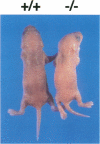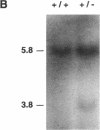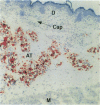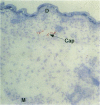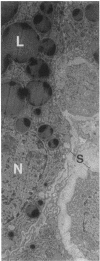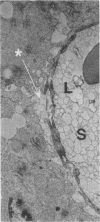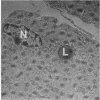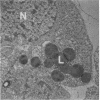Abstract
Lipoprotein lipase (LPL)-deficient mice have been created by gene targeting in embryonic stem cells. At birth, homozygous knockout pups have threefold higher triglycerides and sevenfold higher VLDL cholesterol levels than controls. When permitted to suckle, LPL-deficient mice become pale, then cyanotic, and finally die at approximately 18 h of age. Before death, triglyceride levels are severely elevated (15,087 +/- 3,805 vs 188 +/- 71 mg/dl in controls). Capillaries in tissues of homozygous knockout mice are engorged with chylomicrons. This is especially significant in the lung where marginated chylomicrons prevent red cell contact with the endothelium, a phenomenon which is presumably the cause of cyanosis and death in these mice. Homozygous knockout mice also have diminished adipose tissue stores as well as decreased intracellular fat droplets. By crossbreeding with transgenic mice expressing human LPL driven by a muscle-specific promoter, mouse lines were generated that express LPL exclusively in muscle but not in any other tissue. This tissue-specific LPL expression rescued the LPL knockout mice and normalized their lipoprotein pattern. This supports the contention that hypertriglyceridemia caused the death of these mice and that LPL expression in a single tissue was sufficient for rescue. Heterozygous LPL knockout mice survive to adulthood and have mild hypertriglyceridemia, with 1.5-2-fold elevated triglyceride levels compared with controls in both the fed and fasted states on chow, Western-type, or 10% sucrose diets. In vivo turnover studies revealed that heterozygous knockout mice had impaired VLDL clearance (fractional catabolic rate) but no increase in transport rate. In summary, total LPL deficiency in the mouse prevents triglyceride removal from plasma, causing death in the neonatal period, and expression of LPL in a single tissue alleviates this problem. Furthermore, half-normal levels of LPL cause a decrease in VLDL fractional catabolic rate and mild hypertriglyceridemia, implying that partial LPL deficiency has physiological consequences.
Full text
PDF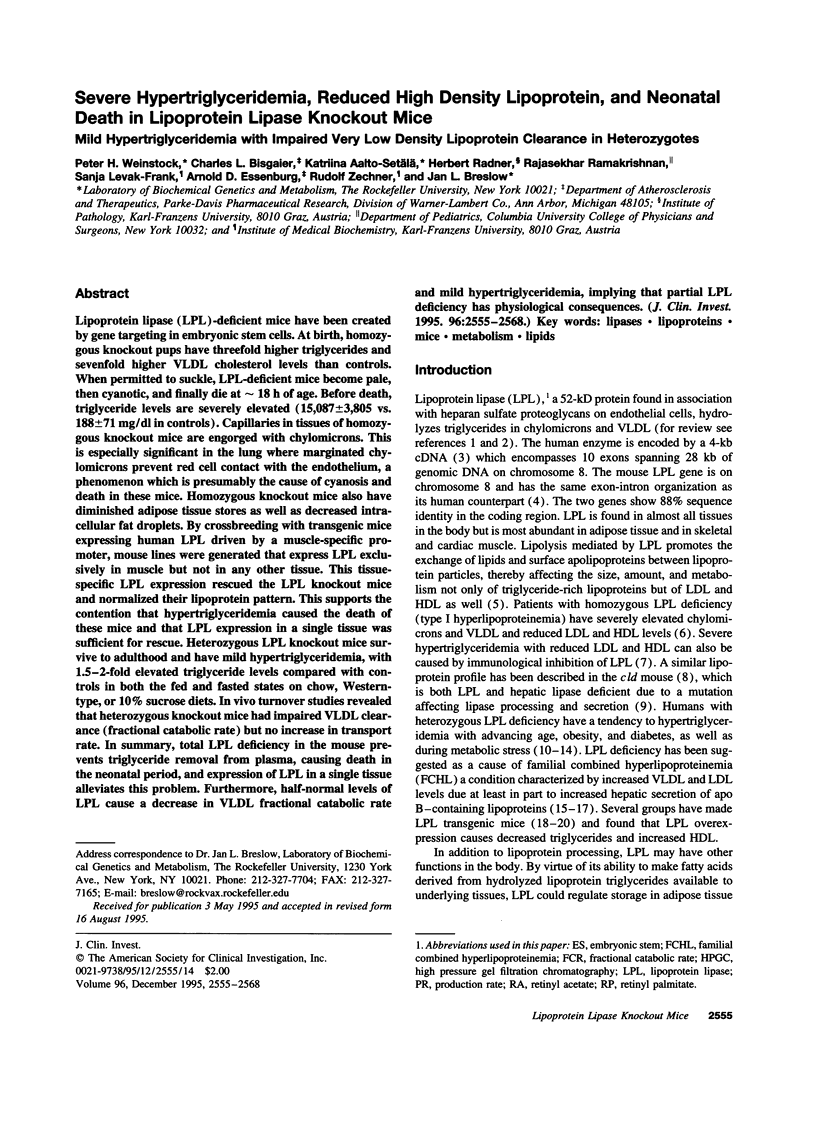

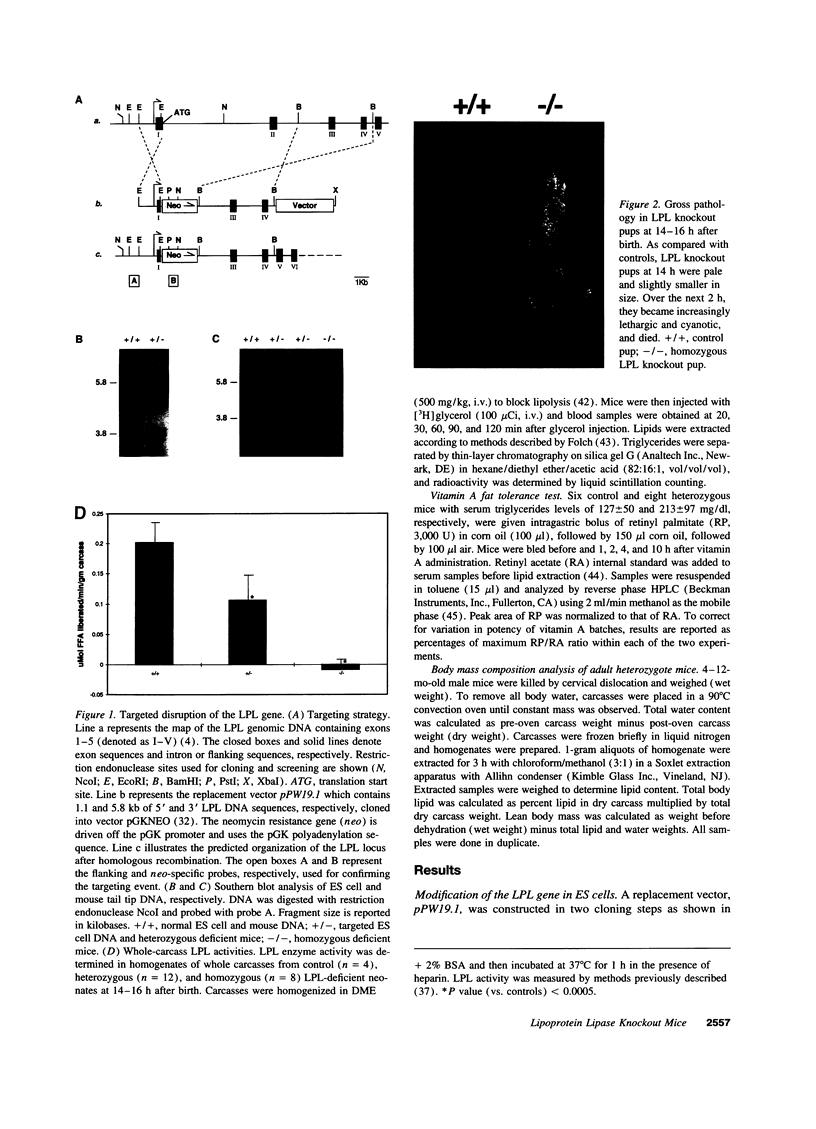

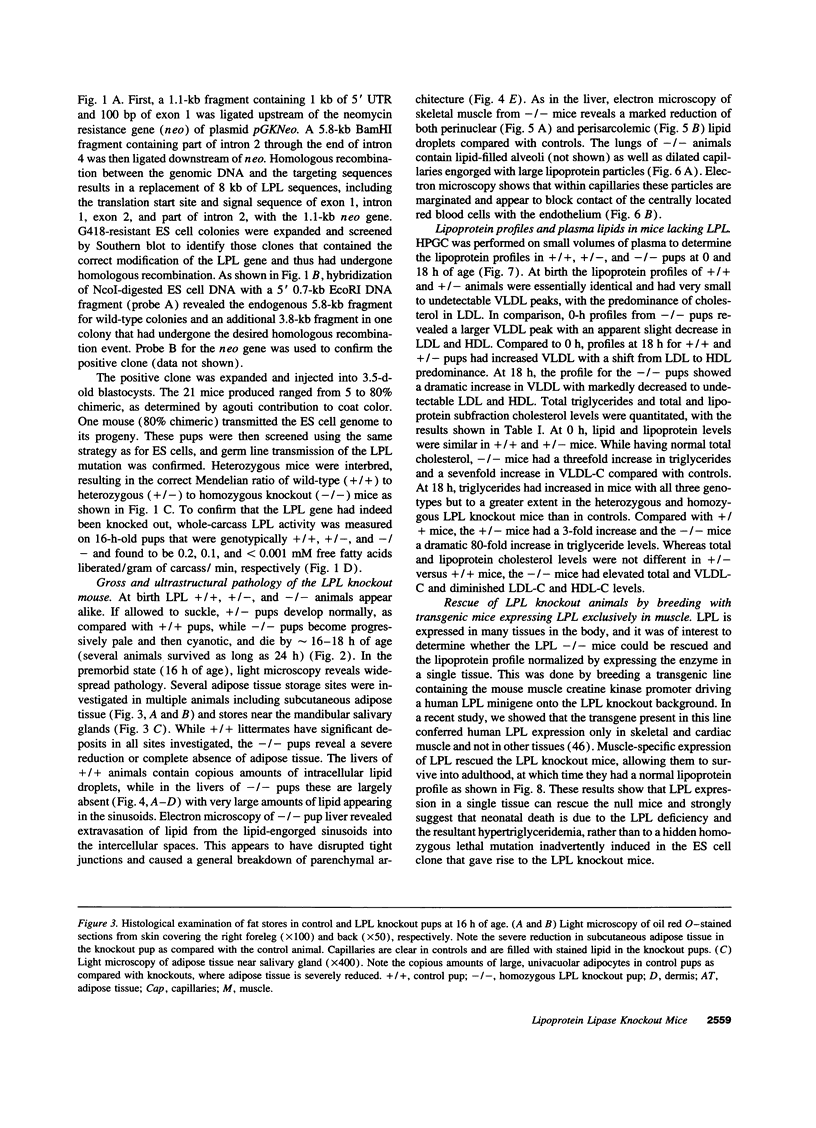
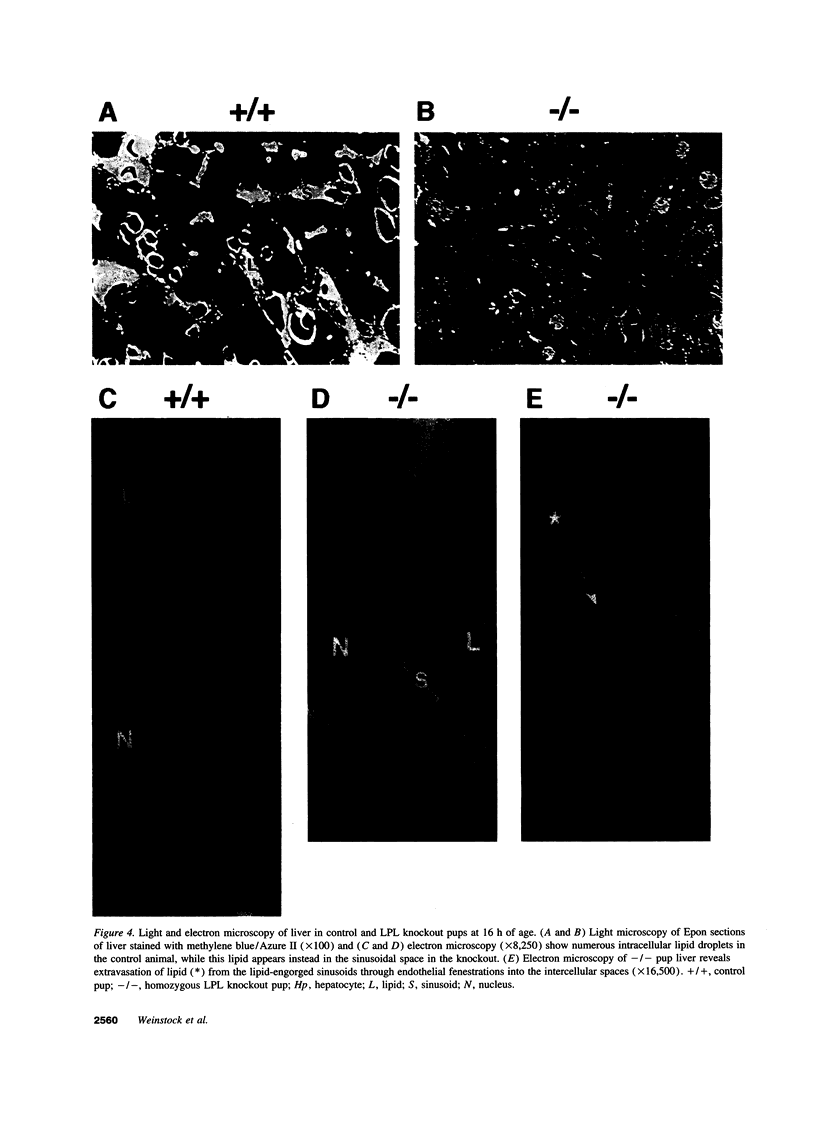
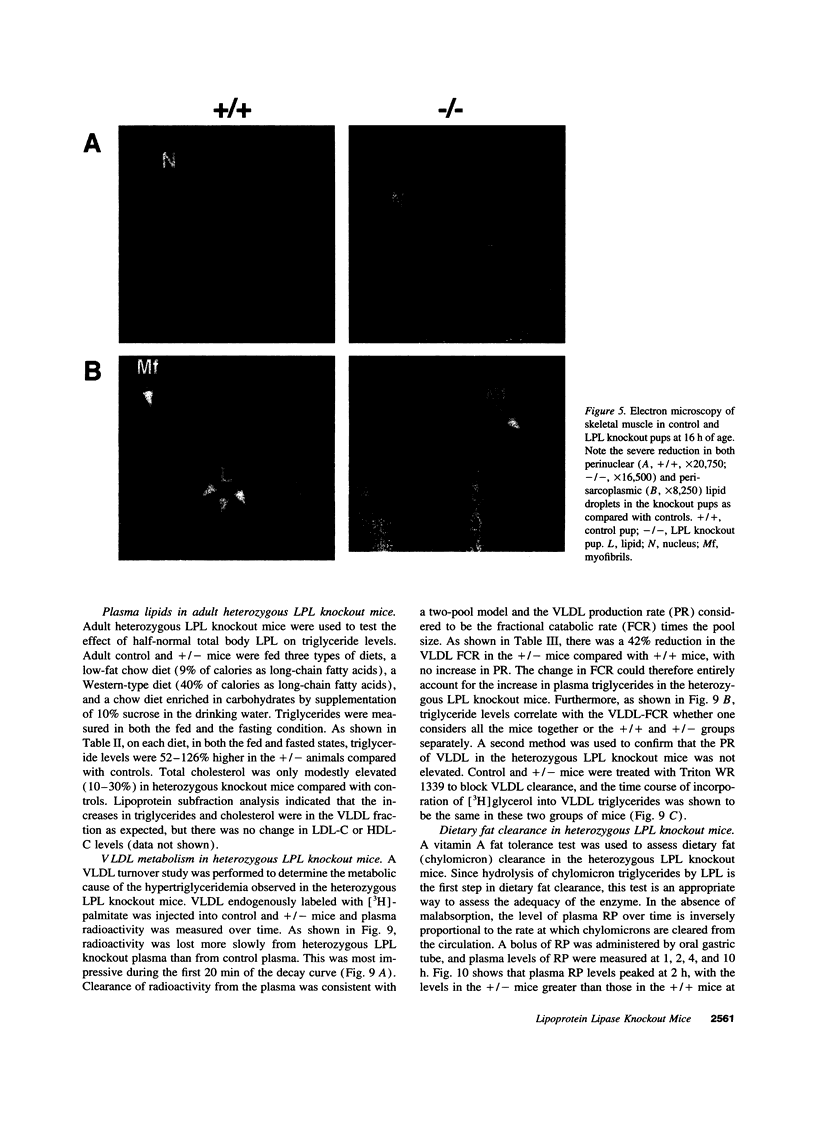
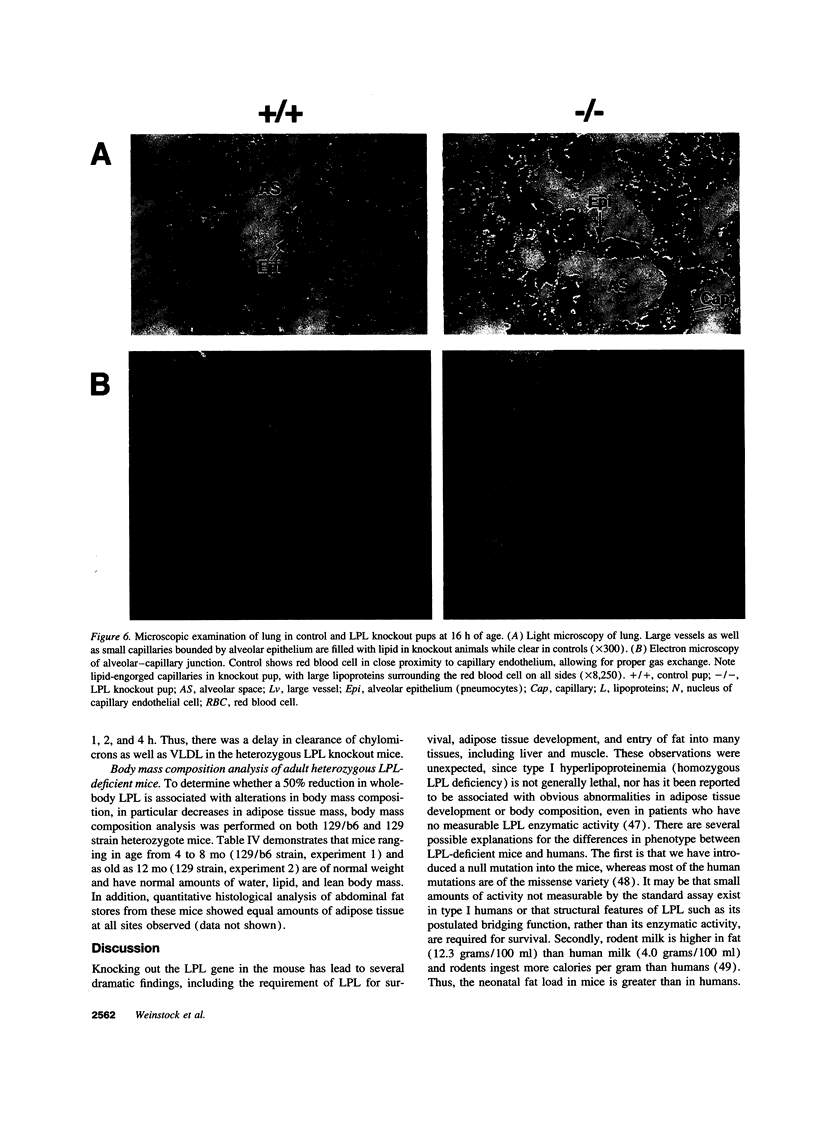



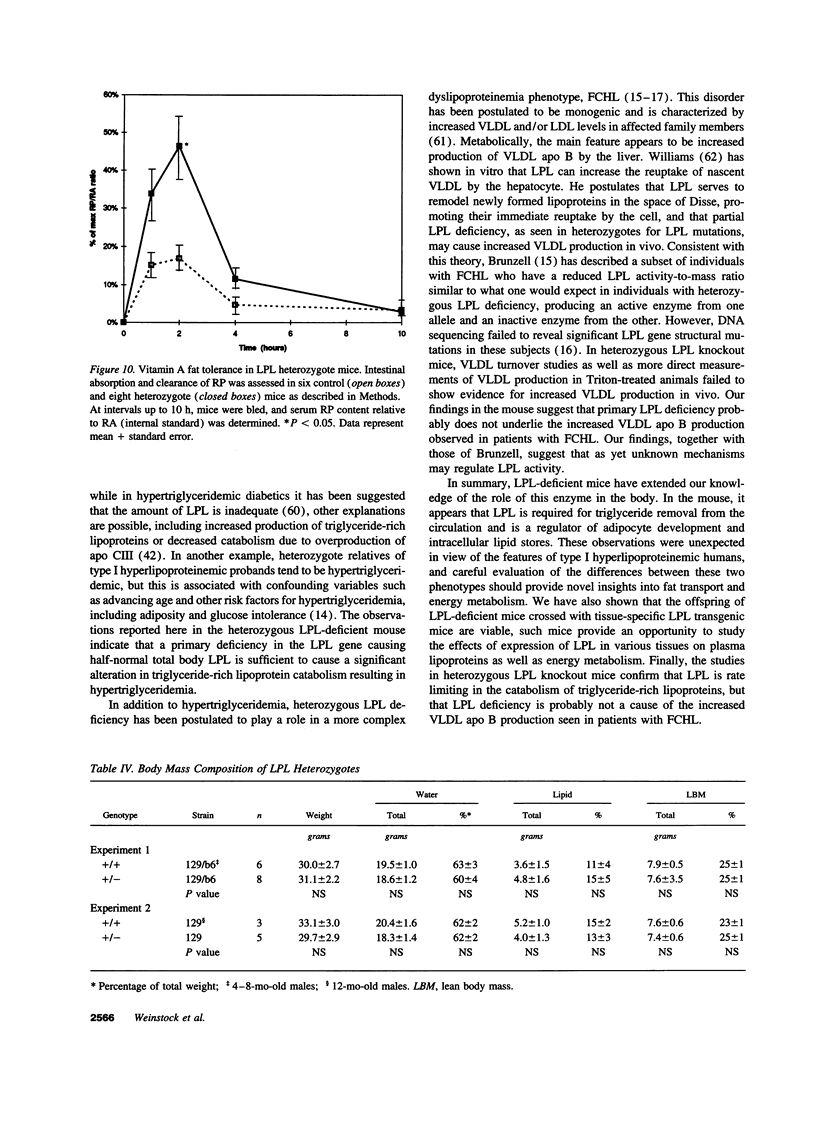
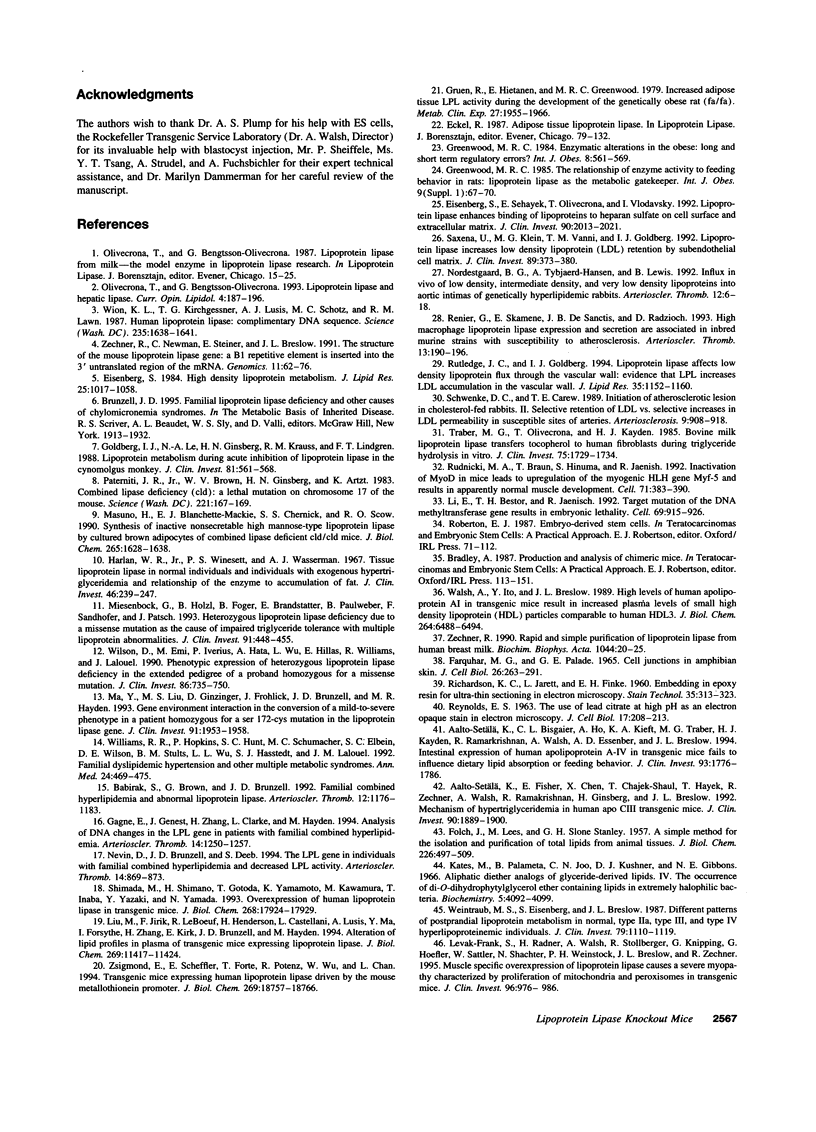
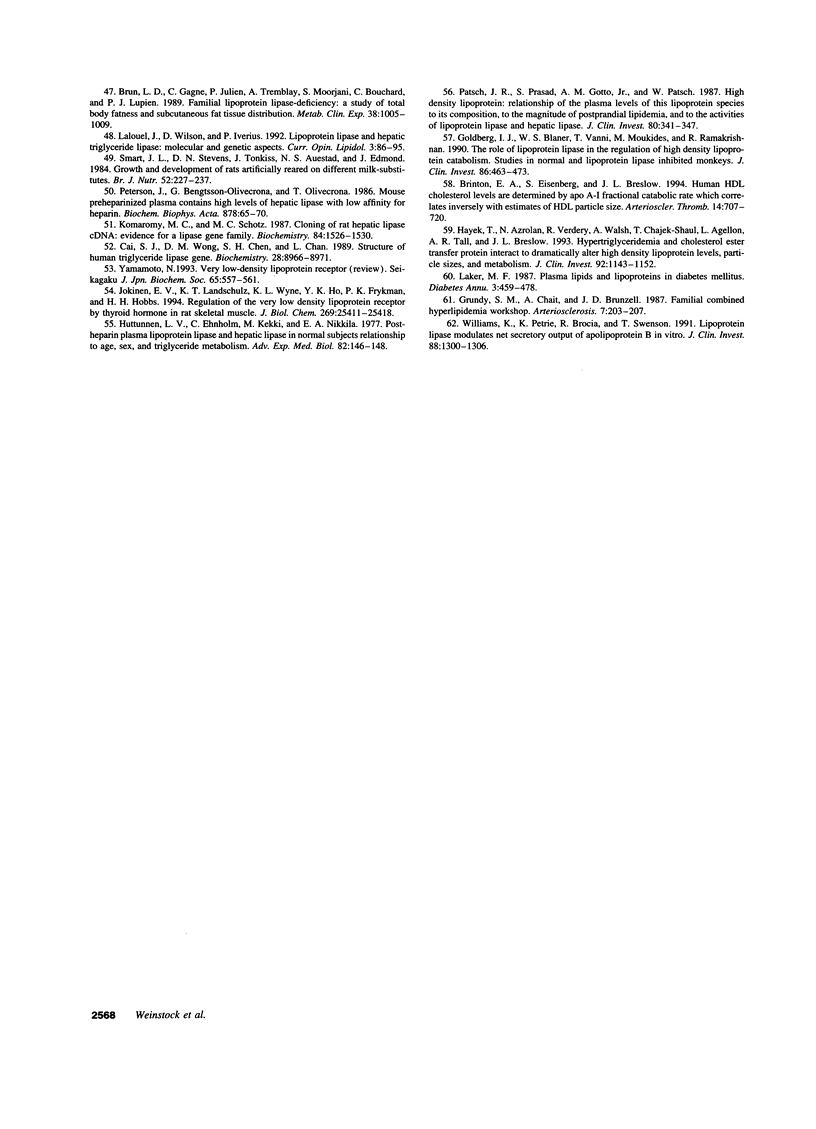
Images in this article
Selected References
These references are in PubMed. This may not be the complete list of references from this article.
- Aalto-Setälä K., Bisgaier C. L., Ho A., Kieft K. A., Traber M. G., Kayden H. J., Ramakrishnan R., Walsh A., Essenburg A. D., Breslow J. L. Intestinal expression of human apolipoprotein A-IV in transgenic mice fails to influence dietary lipid absorption or feeding behavior. J Clin Invest. 1994 Apr;93(4):1776–1786. doi: 10.1172/JCI117163. [DOI] [PMC free article] [PubMed] [Google Scholar]
- Aalto-Setälä K., Fisher E. A., Chen X., Chajek-Shaul T., Hayek T., Zechner R., Walsh A., Ramakrishnan R., Ginsberg H. N., Breslow J. L. Mechanism of hypertriglyceridemia in human apolipoprotein (apo) CIII transgenic mice. Diminished very low density lipoprotein fractional catabolic rate associated with increased apo CIII and reduced apo E on the particles. J Clin Invest. 1992 Nov;90(5):1889–1900. doi: 10.1172/JCI116066. [DOI] [PMC free article] [PubMed] [Google Scholar]
- Babirak S. P., Brown B. G., Brunzell J. D. Familial combined hyperlipidemia and abnormal lipoprotein lipase. Arterioscler Thromb. 1992 Oct;12(10):1176–1183. doi: 10.1161/01.atv.12.10.1176. [DOI] [PubMed] [Google Scholar]
- Brinton E. A., Eisenberg S., Breslow J. L. Human HDL cholesterol levels are determined by apoA-I fractional catabolic rate, which correlates inversely with estimates of HDL particle size. Effects of gender, hepatic and lipoprotein lipases, triglyceride and insulin levels, and body fat distribution. Arterioscler Thromb. 1994 May;14(5):707–720. doi: 10.1161/01.atv.14.5.707. [DOI] [PubMed] [Google Scholar]
- Brun L. D., Gagné C., Julien P., Tremblay A., Moorjani S., Bouchard C., Lupien P. J. Familial lipoprotein lipase-activity deficiency: study of total body fatness and subcutaneous fat tissue distribution. Metabolism. 1989 Oct;38(10):1005–1009. doi: 10.1016/0026-0495(89)90013-9. [DOI] [PubMed] [Google Scholar]
- Cai S. J., Wong D. M., Chen S. H., Chan L. Structure of the human hepatic triglyceride lipase gene. Biochemistry. 1989 Nov 14;28(23):8966–8971. doi: 10.1021/bi00449a002. [DOI] [PubMed] [Google Scholar]
- Eisenberg S. High density lipoprotein metabolism. J Lipid Res. 1984 Oct;25(10):1017–1058. [PubMed] [Google Scholar]
- Eisenberg S., Sehayek E., Olivecrona T., Vlodavsky I. Lipoprotein lipase enhances binding of lipoproteins to heparan sulfate on cell surfaces and extracellular matrix. J Clin Invest. 1992 Nov;90(5):2013–2021. doi: 10.1172/JCI116081. [DOI] [PMC free article] [PubMed] [Google Scholar]
- FOLCH J., LEES M., SLOANE STANLEY G. H. A simple method for the isolation and purification of total lipides from animal tissues. J Biol Chem. 1957 May;226(1):497–509. [PubMed] [Google Scholar]
- Farquhar M. G., Palade G. E. Cell junctions in amphibian skin. J Cell Biol. 1965 Jul;26(1):263–291. doi: 10.1083/jcb.26.1.263. [DOI] [PMC free article] [PubMed] [Google Scholar]
- Gagné E., Genest J., Jr, Zhang H., Clarke L. A., Hayden M. R. Analysis of DNA changes in the LPL gene in patients with familial combined hyperlipidemia. Arterioscler Thromb. 1994 Aug;14(8):1250–1257. doi: 10.1161/01.atv.14.8.1250. [DOI] [PubMed] [Google Scholar]
- Goldberg I. J., Blaner W. S., Vanni T. M., Moukides M., Ramakrishnan R. Role of lipoprotein lipase in the regulation of high density lipoprotein apolipoprotein metabolism. Studies in normal and lipoprotein lipase-inhibited monkeys. J Clin Invest. 1990 Aug;86(2):463–473. doi: 10.1172/JCI114732. [DOI] [PMC free article] [PubMed] [Google Scholar]
- Goldberg I. J., Le N. A., Ginsberg H. N., Krauss R. M., Lindgren F. T. Lipoprotein metabolism during acute inhibition of lipoprotein lipase in the cynomolgus monkey. J Clin Invest. 1988 Feb;81(2):561–568. doi: 10.1172/JCI113354. [DOI] [PMC free article] [PubMed] [Google Scholar]
- Greenwood M. R. Enzymatic alterations in the obese: long or short-term regulatory errors? Int J Obes. 1984;8(5):561–569. [PubMed] [Google Scholar]
- Greenwood M. R. The relationship of enzyme activity to feeding behavior in rats: lipoprotein lipase as the metabolic gatekeeper. Int J Obes. 1985;9 (Suppl 1):67–70. [PubMed] [Google Scholar]
- Gruen R., Hietanen E., Greenwood M. R. Increased adipose tissue lipoprotein lipase activity during the development of the genetically obese rat (fa/fa). Metabolism. 1978 Dec;27(12 Suppl 2):1955–1966. doi: 10.1016/s0026-0495(78)80012-2. [DOI] [PubMed] [Google Scholar]
- Harlan W. R., Jr, Winesett P. S., Wasserman A. J. Tissue lipoprotein lipase in normal individuals and in individuals with exogenous hypertriglyceridemia and the relationship of this enzyme to assimilation of fat. J Clin Invest. 1967 Feb;46(2):239–247. doi: 10.1172/JCI105526. [DOI] [PMC free article] [PubMed] [Google Scholar]
- Hayek T., Azrolan N., Verdery R. B., Walsh A., Chajek-Shaul T., Agellon L. B., Tall A. R., Breslow J. L. Hypertriglyceridemia and cholesteryl ester transfer protein interact to dramatically alter high density lipoprotein levels, particle sizes, and metabolism. Studies in transgenic mice. J Clin Invest. 1993 Sep;92(3):1143–1152. doi: 10.1172/JCI116683. [DOI] [PMC free article] [PubMed] [Google Scholar]
- Huttunen J. K., Ehnholm C., Kekki M., Nikkilä E. A. Postheparin plasma lipoprotein lipase and hepatic lipase in normal human subjects: relationship to age, sex and triglyceride metabolism. Adv Exp Med Biol. 1977;82:146–148. doi: 10.1007/978-1-4613-4220-5_22. [DOI] [PubMed] [Google Scholar]
- Intres R., Goldflam S., Cook J. R., Crabb J. W. Molecular cloning and structural analysis of the human gene encoding cellular retinaldehyde-binding protein. J Biol Chem. 1994 Oct 14;269(41):25411–25418. [PubMed] [Google Scholar]
- Komaromy M. C., Schotz M. C. Cloning of rat hepatic lipase cDNA: evidence for a lipase gene family. Proc Natl Acad Sci U S A. 1987 Mar;84(6):1526–1530. doi: 10.1073/pnas.84.6.1526. [DOI] [PMC free article] [PubMed] [Google Scholar]
- Levak-Frank S., Radner H., Walsh A., Stollberger R., Knipping G., Hoefler G., Sattler W., Weinstock P. H., Breslow J. L., Zechner R. Muscle-specific overexpression of lipoprotein lipase causes a severe myopathy characterized by proliferation of mitochondria and peroxisomes in transgenic mice. J Clin Invest. 1995 Aug;96(2):976–986. doi: 10.1172/JCI118145. [DOI] [PMC free article] [PubMed] [Google Scholar]
- Li E., Bestor T. H., Jaenisch R. Targeted mutation of the DNA methyltransferase gene results in embryonic lethality. Cell. 1992 Jun 12;69(6):915–926. doi: 10.1016/0092-8674(92)90611-f. [DOI] [PubMed] [Google Scholar]
- Liu M. S., Jirik F. R., LeBoeuf R. C., Henderson H., Castellani L. W., Lusis A. J., Ma Y., Forsythe I. J., Zhang H., Kirk E. Alteration of lipid profiles in plasma of transgenic mice expressing human lipoprotein lipase. J Biol Chem. 1994 Apr 15;269(15):11417–11424. [PubMed] [Google Scholar]
- Ma Y., Liu M. S., Ginzinger D., Frohlich J., Brunzell J. D., Hayden M. R. Gene-environment interaction in the conversion of a mild-to-severe phenotype in a patient homozygous for a Ser172-->Cys mutation in the lipoprotein lipase gene. J Clin Invest. 1993 May;91(5):1953–1958. doi: 10.1172/JCI116414. [DOI] [PMC free article] [PubMed] [Google Scholar]
- Masuno H., Blanchette-Mackie E. J., Chernick S. S., Scow R. O. Synthesis of inactive nonsecretable high mannose-type lipoprotein lipase by cultured brown adipocytes of combined lipase-deficient cld/cld mice. J Biol Chem. 1990 Jan 25;265(3):1628–1638. [PubMed] [Google Scholar]
- Miesenböck G., Hölzl B., Föger B., Brandstätter E., Paulweber B., Sandhofer F., Patsch J. R. Heterozygous lipoprotein lipase deficiency due to a missense mutation as the cause of impaired triglyceride tolerance with multiple lipoprotein abnormalities. J Clin Invest. 1993 Feb;91(2):448–455. doi: 10.1172/JCI116222. [DOI] [PMC free article] [PubMed] [Google Scholar]
- Nevin D. N., Brunzell J. D., Deeb S. S. The LPL gene in individuals with familial combined hyperlipidemia and decreased LPL activity. Arterioscler Thromb. 1994 Jun;14(6):869–873. doi: 10.1161/01.atv.14.6.869. [DOI] [PubMed] [Google Scholar]
- Nordestgaard B. G., Tybjaerg-Hansen A., Lewis B. Influx in vivo of low density, intermediate density, and very low density lipoproteins into aortic intimas of genetically hyperlipidemic rabbits. Roles of plasma concentrations, extent of aortic lesion, and lipoprotein particle size as determinants. Arterioscler Thromb. 1992 Jan;12(1):6–18. doi: 10.1161/01.atv.12.1.6. [DOI] [PubMed] [Google Scholar]
- Paterniti J. R., Jr, Brown W. V., Ginsberg H. N., Artzt K. Combined lipase deficiency (cld): a lethal mutation on chromosome 17 of the mouse. Science. 1983 Jul 8;221(4606):167–169. doi: 10.1126/science.6857276. [DOI] [PubMed] [Google Scholar]
- Patsch J. R., Prasad S., Gotto A. M., Jr, Patsch W. High density lipoprotein2. Relationship of the plasma levels of this lipoprotein species to its composition, to the magnitude of postprandial lipemia, and to the activities of lipoprotein lipase and hepatic lipase. J Clin Invest. 1987 Aug;80(2):341–347. doi: 10.1172/JCI113078. [DOI] [PMC free article] [PubMed] [Google Scholar]
- Peterson J., Bengtsson-Olivecrona G., Olivecrona T. Mouse preheparin plasma contains high levels of hepatic lipase with low affinity for heparin. Biochim Biophys Acta. 1986 Aug 14;878(1):65–70. doi: 10.1016/0005-2760(86)90344-9. [DOI] [PubMed] [Google Scholar]
- REYNOLDS E. S. The use of lead citrate at high pH as an electron-opaque stain in electron microscopy. J Cell Biol. 1963 Apr;17:208–212. doi: 10.1083/jcb.17.1.208. [DOI] [PMC free article] [PubMed] [Google Scholar]
- RICHARDSON K. C., JARETT L., FINKE E. H. Embedding in epoxy resins for ultrathin sectioning in electron microscopy. Stain Technol. 1960 Nov;35:313–323. doi: 10.3109/10520296009114754. [DOI] [PubMed] [Google Scholar]
- Renier G., Skamene E., DeSanctis J. B., Radzioch D. High macrophage lipoprotein lipase expression and secretion are associated in inbred murine strains with susceptibility to atherosclerosis. Arterioscler Thromb. 1993 Feb;13(2):190–196. doi: 10.1161/01.atv.13.2.190. [DOI] [PubMed] [Google Scholar]
- Rudnicki M. A., Braun T., Hinuma S., Jaenisch R. Inactivation of MyoD in mice leads to up-regulation of the myogenic HLH gene Myf-5 and results in apparently normal muscle development. Cell. 1992 Oct 30;71(3):383–390. doi: 10.1016/0092-8674(92)90508-a. [DOI] [PubMed] [Google Scholar]
- Rutledge J. C., Goldberg I. J. Lipoprotein lipase (LpL) affects low density lipoprotein (LDL) flux through vascular tissue: evidence that LpL increases LDL accumulation in vascular tissue. J Lipid Res. 1994 Jul;35(7):1152–1160. [PubMed] [Google Scholar]
- Saxena U., Klein M. G., Vanni T. M., Goldberg I. J. Lipoprotein lipase increases low density lipoprotein retention by subendothelial cell matrix. J Clin Invest. 1992 Feb;89(2):373–380. doi: 10.1172/JCI115595. [DOI] [PMC free article] [PubMed] [Google Scholar]
- Schwenke D. C., Carew T. E. Initiation of atherosclerotic lesions in cholesterol-fed rabbits. II. Selective retention of LDL vs. selective increases in LDL permeability in susceptible sites of arteries. Arteriosclerosis. 1989 Nov-Dec;9(6):908–918. doi: 10.1161/01.atv.9.6.908. [DOI] [PubMed] [Google Scholar]
- Shimada M., Shimano H., Gotoda T., Yamamoto K., Kawamura M., Inaba T., Yazaki Y., Yamada N. Overexpression of human lipoprotein lipase in transgenic mice. Resistance to diet-induced hypertriglyceridemia and hypercholesterolemia. J Biol Chem. 1993 Aug 25;268(24):17924–17929. [PubMed] [Google Scholar]
- Smart J. L., Stephens D. N., Tonkiss J., Auestad N. S., Edmond J. Growth and development of rats artificially reared on different milk-substitutes. Br J Nutr. 1984 Sep;52(2):227–237. doi: 10.1079/bjn19840091. [DOI] [PubMed] [Google Scholar]
- Traber M. G., Olivecrona T., Kayden H. J. Bovine milk lipoprotein lipase transfers tocopherol to human fibroblasts during triglyceride hydrolysis in vitro. J Clin Invest. 1985 May;75(5):1729–1734. doi: 10.1172/JCI111883. [DOI] [PMC free article] [PubMed] [Google Scholar]
- Walsh A., Ito Y., Breslow J. L. High levels of human apolipoprotein A-I in transgenic mice result in increased plasma levels of small high density lipoprotein (HDL) particles comparable to human HDL3. J Biol Chem. 1989 Apr 15;264(11):6488–6494. [PubMed] [Google Scholar]
- Weintraub M. S., Eisenberg S., Breslow J. L. Different patterns of postprandial lipoprotein metabolism in normal, type IIa, type III, and type IV hyperlipoproteinemic individuals. Effects of treatment with cholestyramine and gemfibrozil. J Clin Invest. 1987 Apr;79(4):1110–1119. doi: 10.1172/JCI112926. [DOI] [PMC free article] [PubMed] [Google Scholar]
- Williams K. J., Petrie K. A., Brocia R. W., Swenson T. L. Lipoprotein lipase modulates net secretory output of apolipoprotein B in vitro. A possible pathophysiologic explanation for familial combined hyperlipidemia. J Clin Invest. 1991 Oct;88(4):1300–1306. doi: 10.1172/JCI115434. [DOI] [PMC free article] [PubMed] [Google Scholar]
- Williams R. R., Hopkins P. N., Hunt S. C., Schumacher M. C., Elbein S. C., Wilson D. E., Stults B. M., Wu L. L., Hasstedt S. J., Lalouel J. M. Familial dyslipidaemic hypertension and other multiple metabolic syndromes. Ann Med. 1992 Dec;24(6):469–475. doi: 10.3109/07853899209166998. [DOI] [PubMed] [Google Scholar]
- Wilson D. E., Emi M., Iverius P. H., Hata A., Wu L. L., Hillas E., Williams R. R., Lalouel J. M. Phenotypic expression of heterozygous lipoprotein lipase deficiency in the extended pedigree of a proband homozygous for a missense mutation. J Clin Invest. 1990 Sep;86(3):735–750. doi: 10.1172/JCI114770. [DOI] [PMC free article] [PubMed] [Google Scholar]
- Wion K. L., Kirchgessner T. G., Lusis A. J., Schotz M. C., Lawn R. M. Human lipoprotein lipase complementary DNA sequence. Science. 1987 Mar 27;235(4796):1638–1641. doi: 10.1126/science.3823907. [DOI] [PubMed] [Google Scholar]
- Yamamoto N. [Very low-density lipoprotein (VLDL) receptor]. Seikagaku. 1993 Jul;65(7):557–561. [PubMed] [Google Scholar]
- Zechner R., Newman T. C., Steiner E., Breslow J. L. The structure of the mouse lipoprotein lipase gene: a B1 repetitive element is inserted into the 3' untranslated region of the mRNA. Genomics. 1991 Sep;11(1):62–76. doi: 10.1016/0888-7543(91)90102-k. [DOI] [PubMed] [Google Scholar]
- Zechner R. Rapid and simple isolation procedure for lipoprotein lipase from human milk. Biochim Biophys Acta. 1990 May 1;1044(1):20–25. doi: 10.1016/0005-2760(90)90213-h. [DOI] [PubMed] [Google Scholar]
- Zsigmond E., Scheffler E., Forte T. M., Potenz R., Wu W., Chan L. Transgenic mice expressing human lipoprotein lipase driven by the mouse metallothionein promoter. A phenotype associated with increased perinatal mortality and reduced plasma very low density lipoprotein of normal size. J Biol Chem. 1994 Jul 22;269(29):18757–18766. [PubMed] [Google Scholar]



